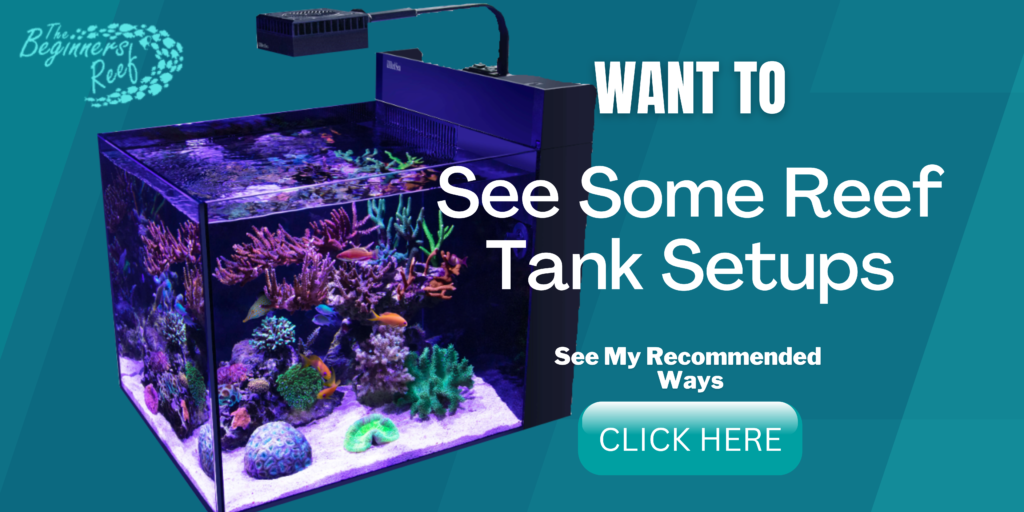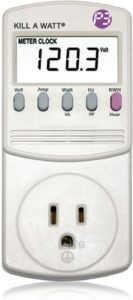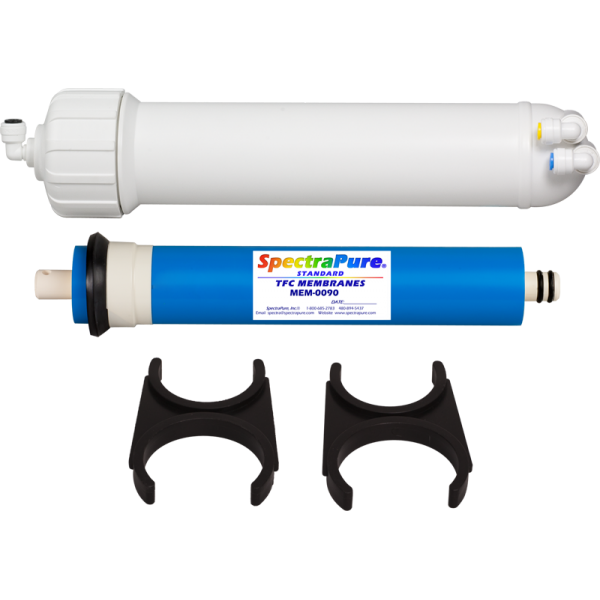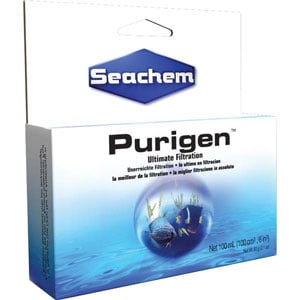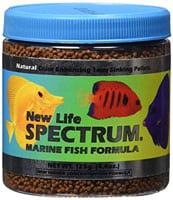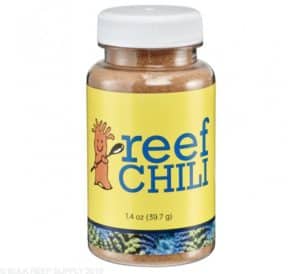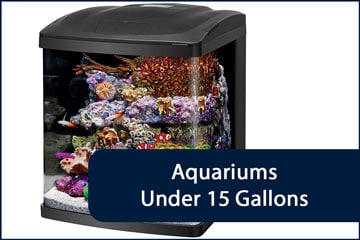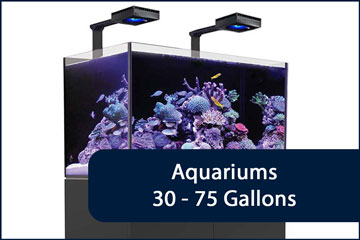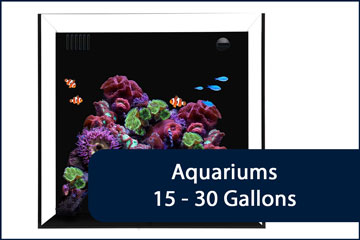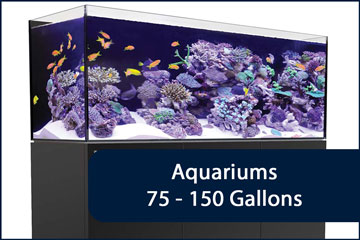When you are first looking at buying a saltwater aquarium it is easy to tally up how much it is going to cost you to purchase all of the aquarium, equipment, and livestock. It is a little more tricky to work out how much it is going to cost you to run it each month.
Every month there are running costs associated with the aquarium and many people don’t even consider these. Depending on where you live, the cost of electricity or water could have you panicking when your first utility bill arrives!
To buy and equip a saltwater aquarium can be as low as $500, with most averaging around $2000-$3000. A rough monthly budget to run a saltwater aquarium is around $25 – $100 per month based on tank size. This is based on consumables & utilities used. Coral, invertebrates, and fish are extra.
In this article we are going to split it up into two sections:
- Cost to buy and equip a tank
- Cost to run the tank each month
Each of these takes a little bit of time to work out, but once you know what equipment you are going to have it makes it a lot easier.
The main thing to remember when planning your aquarium is the bigger the tank, the more expensive it will be to purchase the equipment, the more it will cost to fill it with livestock and coral and the more consumables and utilities it will consume to run.
A 30 gallon reef will be far cheaper overall than a 230 gallon reef!
How Much Does it Cost To Set up a Saltwater Aquarium?
Typical Setup Costs for a Saltwater Aquarium Bought Brand New:
| Item | 15G All-In-One Aquarium | 35G All-In-One Aquarium | 75G Aquarium | 130G Aquarium |
| Tank Kit | $300 | $800 | $1,900 | $3,840 |
| Sump | N/A | Inc. | Inc. | Inc. |
| Light | $175 | $250 | $1,015 | Inc. |
| Protein Skimmer | $140 | $200 | $320 | $430 |
| Return Pump | Inc. | $60 | $85 | $110 |
| Heater | $23 | $29 | $32 | $38 |
| Filter Media | Inc. | $18 | $42 | $90 |
| Substrate | $14 | $30 | $60 | $90 |
| Rock | $30 | $60 | $300 | $450 |
| Initial Fill Salt | $12 | $30 | $48 | $48 |
| TOTAL: | $690 | $1,477 | $3,802 | $5,096 |
Many aquarium setups can be had if you scan the classified ads and look for hobbyists leaving the hobby, but for those who want the pristine look of everything new, the above costings are going to be the starting point.
There are so many types of saltwater aquarium systems to pick from including All-In-One (AIO) setups where all the filtration is hidden in a rear compartment, tank and sump systems from the manufacturer or you could source all the components yourself and build your own custom setup.
All options are available for pretty much every tank size and for every budget.
If you would like to see some complete setup examples of 11 tanks ranging in size from 15 gallons up to 150 gallons please click on the Banner below:
To help ensure you get all the equipment needed for your new aquarium here is the shopping list you will need to get started with the bare bones:
- Aquarium
- Stand (If Required)
- Sump (If not an AIO)
- Return Pump (If not Inc.)
- Light System (If not Inc.)
- Protein Skimmer (If not Inc.)
- Heater
- Test Kits
- Live Bacteria Culture – To Start the Cycle
- Filter Media – ChemiPure, Purigen, Activated Carbon etc.
- Substrate
- Rock – Live or Dry
- Salt Mix
- Refractometer
- Digital Thermometer
Not essential for the startup but highly recommended:
- Automatic Top-Off System
- WaveMaker/Powerhead/Gyre Pumps
- RO/DI Tap Water Filtration System
- Substrate Vacuum
- Magnetic Algae Cleaner
Once you have all the aquarium set up and the tank is finally cycled you will then want to start purchasing fish, invertebrates and coral. This alone is going to set you back several hundred per month for at least the next 12-24 months
You have to add livestock slowly to your new aquarium and allow the bacteria to multiply each time you add new inhabitants. This is why it is always best to only add a few things every 1-2 weeks minimum.
There are so many things to cover with setting up a new tank I highly advise you to head over to my Article Index and read as much as you can. I have over 100 articles about the equipment, the cycle, when to buy, what to buy and what to stay away from. You can find it by clicking on the link below:
The Beginners Reef Article Index
How Much Does it Cost To Run a Saltwater Aquarium?
Saltwater Aquariums can cost anywhere from $15-$200 per month on average to run and maintain. The cost of electricity water, filter media, and salt can all be broken down into a rough monthly budget. Most items will last several months but if a little is put aside each month it helps.
This section is going to show you how you can break down what you will consume every month so you can apply it to your own aquarium and it will give you a rough starting point for budgeting your running costs.
it is important to know how much an aquarium is going to cost once it is set up because just like owning any other pet, once you start you are committed for years to come. By using these steps you will soon find out if you can afford a slightly bigger tank, or if you need to downsize a little to make it more manageable on the bank balance.
Monthly Rough Costing Guide To Run A Saltwater Aquarium:
| Product | 15G All-In-One Aquarium | 25 Gallon Aquarium | 50 Gallon Aquarium | 100 Gallon Aquarium |
| Salt | $1.95 | $3.25 | $6.50 | $13.00 |
| Activated Carbon | Use Purigen | Use Purigen | $1.00 | $2.00 |
| Granular Ferric Oxide | Use ChemiPure | Use ChemiPure | $2.50 | $5.00 |
| Purigen | $1.05 | $1.75 | – | – |
| ChemiPure Elite | $0.90 | $1.50 | – | – |
| Bio Pellets | Use ChemiPure | Use ChemiPure | $1.25 | $2.50 |
| Test Kits | $3.16 | $3.16 | $3.16 | $3.16 |
| Filter Floss | $0.30 | $0.50 | $1.00 | $2.00 |
| RO/DI Filters | $1.15 | $1.90 | $3.75 | $7.50 |
| Food | $1.00 | $1.60 | $3.25 | $6.50 |
| Electricity | $3.50 | $10.50 | $13.00 | $25.00 |
| Monthly Budget | $15.00 | $25.00 | $35.00 | $65.00 |
Note: Table is approximate monthly costs based on manufacturer recommended times, retail costs, LED light system, a regular stocking level, and a 10% water change each week. Test kits for Ammonia, Nitrate and Ph Only.
Supplemental dosing and T5/MH bulb changes are not accounted for in this table. Electricity is based on 11.13 ¢/kWh. This table is rough costings and with so many variables your cost estimations can be dramatically higher or lower depending on your setup.
This article will guide you through how to work out your approximate running costs for all the categories above with some great examples. What this article is not going to detail is setting up your aquarium and stocking your aquarium costs, eg: Livestock, Coral etc.
You can view a great selection of articles related to these topics at the bottom of the page.
Electricity Costs To Run A Saltwater Aquarium
When you start to put together the items required to run a saltwater aquarium you will soon start to see just how many items are needed just to support life. Pretty much every single one of these products will need to be supplied with power, which is going to cost you money each month.
How much these are going to cost you each month depends on 3 main factors:
Cost Per kWh:
Your cost of electricity per kWh (Kilowatt Hours) from the utility company – You can find this number on your utility bill. For instance the average 2022 cost per kWh for:-
California – 28.71 ¢/kWh (Cents Per Kilowatt Hour)
Florida – 14.27 ¢/kWh
Wattage:
The wattage of the item to be run – This can easily be found in the ‘Product Description Section‘ of the item at AquariumSpecialty.com(Link).
For instance the REEF OCTOPUS CLASSIC CLSC-150INT Protein Skimmer:
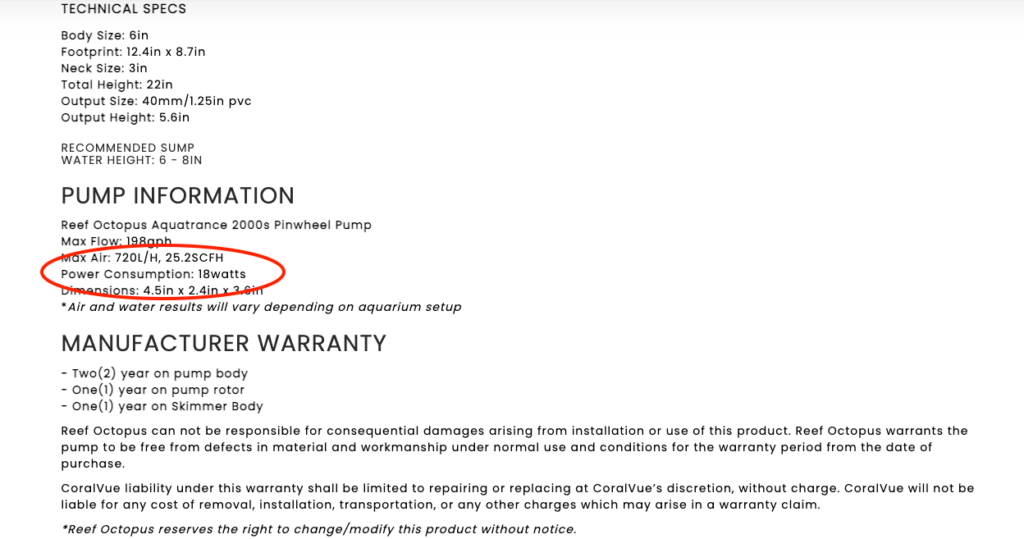
Run Time:
How long does the item run for each day? Items like return pumps and protein skimmers run 24 hours a day, whereas lights or chillers may only run for 12 hours each day.
When calculating the cost of heaters I base my calculations on 50%. Because a heater clicks on and off throughout the day I base the run time on 50%. So heaters are powered for 24 hours each day, but they will be off for maybe half that time, hence 50%.
If you live in a hot climate like Florida or Arizona, your heater may only be on for 10% every 24 hours, but this guide is just a generalization.
For Chillers, they may only be powered for 2 months a year and only for 8 hours during those days, then only ON and cooling for 50% of the time during those hours. Again, you will have to adjust the math to suit your particular setup.
Aquarium Electrical Cost Calculations
If you are like my wife you could be horrible at Math (She will kill me for telling you that if she reads this!) and trying to figure out your power consumption may be tough. I created a calculator in excel to help you!
It is super simple to use:
STEP 1 – Download The Calculator
The excel calculator is available to download below. I tried to embed it into this page but that was above my programming skills!
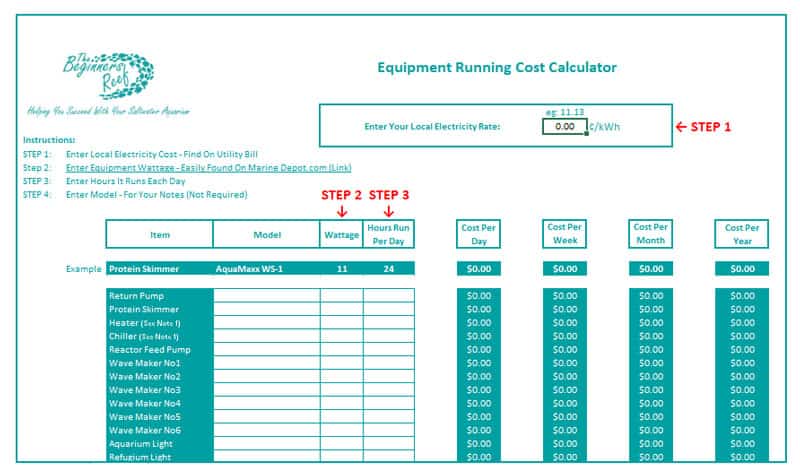
STEP 2 – Get Your Electric Bill
On your electricity bill it will tell you your rate for electricity. This should look something like 19.90 ¢/kWh, the figure will be different for each owner. Enter this value into the box marked STEP 1 on the calculator.
STEP 3 – Find Wattage
Once you have decided on the items you have or are going to purchase, head over to AquariumSpecialty.com and look at each product and find the wattage for it.
Find the line associated with the item on the calculator eg: Heater and enter the wattage into the column marked STEP 2.
DC Watts
If your product is a DC-based unit this is a whole different ball game! I’ve spent days trying to get answers on how to convert DC watts to AC Watts but it’s not that simple apparently!
There are two ways you can find out the AC wattage of the product if it’s not listed on any website:
- Look at the wattage on the label of the power supply for the unit.
- Buy a $20 Kill-A-Watt meter and plug in your item. This will tell you the wattage it draws.
You can find it HERE at Amazon.com.
STEP 4 – Run Time
Enter the run time for each item in the column marked STEP 3.
For heaters and chillers, the calculator already drops the value to 50%. So for heaters just enter 24 for 24 hours. For Chillers, just enter in how many hours a day it runs. Also, be aware that this will calculate the yearly total for it running all year. You can easily see the daily, weekly, and monthly costs for it though.
To do the math yourself here are the equations the calculator uses:
Example: Return Pump
Return Pump = 25 Watts.
It runs 24 hours Per Day.
Example Rate = 13.45 ¢/kWh.
25 Watts/1000 = 0.025 kWh – KiloWatt Hours (How many 1000 watts per hour)
| 0.025kWh x 13.45¢ | = 0.34¢ to run each hour |
| 0.34¢ x 24 hours | = 8.07¢ to run each day |
| 8.07¢ x 7 days | = 56.49¢ to run each week |
| 56.49¢ x 4 weeks | = $2.26 to run each month |
| $2.26 x 12 months | = $27.11 to run each year |
Water Costs To Run A Saltwater Aquarium
Water doesn’t cost that much right? Well just like electricity it can soon add up. Especially if you have a 150-gallon aquarium and are changing 15 gallons each week and topping off 2 gallons of evaporation each day!
The second part that many aquarists didn’t realize is just how much water goes to waste from an RO/DI water filtration unit.
Most of the regular RO/DI units make up clean, 0TDS water at a rate of roughly 1 gallon of filtered water to 5-6 gallons of wasted water!
Take the 150 gallon tank mentioned above as an example:
Each Week:-
15 Gallons for water change
2 Gallons x 7 days for top off
29 Gallons of filtered water each week
29 x 5 = 145 Gallons of wasted water each week
Total Aquarium Water Consumption:-
29+145 = 174 Gallons of water per week
696 Gallons per month
8,352 Gallons per year
You can instantly half the wasted water amount by purchasing a Water Saver Kit for your RO/DI filter like THIS ONE from Amazon.com for $55:
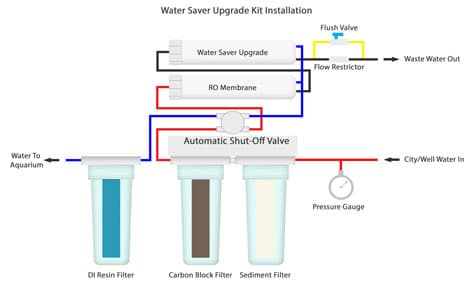
Total Aquarium Water Consumption With Water Saver:-
29 Gallons of filtered water each week
29 x 2 = 58 Gallons of wasted water each week
29+58 = 87 Gallons of water per week
348 Gallons per month
4,176 Gallons per year!
That $60 water saver saves you 4,176 gallons of water every year!
Aquarium Water Cost Calculations
Just like electricity, your water rate will vary depending on where you live. This will also be shown on your bill in one of the following formats:
- Cost Per Gallon – CPG
- Cost Per Cubic Feet – CCF
- Cost Per Cubic Gallon – CCG
- Cost per Cubic Hundred Feet – CHF or CcF (1CcF = 748 Gallons)
We will use the above 150 gallon aquarium against the Charleston SC, Water Rate for 2022:
Minimum Bill for Inside City – 3/4″ Connection = $13.65
Minimum Bill includes 2Ccf = 1,496 gallons used for the entire home
Let’s say your household uses the 2CcF and your aquarium now puts it over the Minimum Bill threshold:
Each CcF = 748 Gallons = $1.76
Water used for Aquarium = 348 Gallons With Water Saver
= $0.81/month extra charges
Water used for Aquarium = 696 Gallons Without Water Saver
= $1.63/month extra charges
As you can see water is not really a big charge but it can add up, especially if you begin to get alot of evaporation!
The main thing with this should be that we all need to do our part for the planet and a Water Saver Kit is a must for everyone. Saving half the amount of water that we can is a no brainer!
Supplies Cost To Run A Saltwater Aquarium
This is the biggest expenditure out of all the categories to running a saltwater aquarium and salt being one of the biggest.
Each aquarium is going to vary as to how much supplies it will consume on a monthly basis and it all comes down to the following factors:
Amount of Water Volume
The more water you have, the more you will need for water changes. The more supplemental elements you will need to dose as your corals begin to grow. The more medications you will need for the given volume of water, and the more salt you need to add when doing water changes.
Amount of Bioload
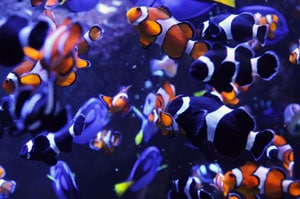
The more living organisms you have in your aquarium, the more waste they will produce. The more food you feed, the more chance of uneaten food decaying and breaking down. This requires filter material and consumables to be changed more often.
Rate of Coral Growth
Once your corals begin to get fat and happy they can grow at a fairly rapid rate. To be able to grow this quickly they begin to consume the elements from the water faster than the water changes can replace them. This is when supplemental dosing comes into play.
Just like water volume, you have to dose enough to keep the parameters of Alkalinity, Calcium and Magnesium stable. The more water and the faster the growth, the quicker you go through the supplemental fluids.
Here is a list of the typical supplies you will go through each month. Some aquariums will rapidly deplete these and some will be good for months:
Salt
This is the one product you can go through quickly but it all depends on your water volume and your water change frequency.
For Example:
My total volume is 90 Gallons with my aquarium, sump, and frag tank. I change 10 gallons every week, roughly 10%.
I buy the Instant Ocean Reef Crystals 200g Box. Each gallon requires 1/2 cup of salt granules, so each week I use about 5 cups of salt.
Each box will last me around 5 months and I buy it for around $60. I usually wait until it goes on sale on Amazon for cheap and then buy a few boxes.
Salt costs me roughly $0.13 per gallon each month on 10% a week water change.
Ex:
(25 Gal Aquarium = $3.25/month)
(50 Gal Aquarium = $6.50/month)
(100 Gal Aquarium = $13.00/month)
Activated Carbon
Used for removing organic pollutants, toxins and helps to polish the water.
There are many different types of activated carbon with each having different amounts per gallon. I use the Bulk Premium Activated Carbon in a reactor. The carbon I use is roughly dosed at 1/2 Cup for 40 gallons. I place 1 to 1.5 cups in my Reactor and I change it every month.
I buy the bulk containers for around $20 and will last me roughly 1 year.
Activated Carbon in bulk costs me roughly $0.02 per gallon each month.
Ex:
(25 Gal Aquarium = $0.50/month)
(50 Gal Aquarium = $1.00/month)
(100 Gal Aquarium = $2.00/month)
GFO – Granular Ferric Oxide
GFO help to produce phosphates in your aquarium. It can work great to help prevent algae. When I used this product I would also buy this in bulk for around $50. Depending on the individual manufacturer the dosage I had was around 1/2 cup per 50 gallons. I would use about 1 cup and replace it every 6 weeks. The bulk container contained roughly 8 cups and would last me roughly 1 year.
GFO in bulk would cost me roughly $0.05 per gallon each month.
Ex:
(25 Gal Aquarium = $1.25/month)
(50 Gal Aquarium = $2.20/month)
(100 Gal Aquarium = $4.20/month)
Purigen
A product that is a great alternative to Activated Carbon but with the added benefit of helping to reduce ammonia, nitrates, and nitrites.
100ml is recommended for 100 gallons and would last 6 months according to the manufacturer. 100ml is roughly $10.
If I were to use Purigen it would cost me roughly $0.07 per gallon each month.
(25 Gal Aquarium = $0.42/month)
(50 Gal Aquarium = $0.83/month)
(100 Gal Aquarium = $1.67/month)
ChemiPure Elite
This is an engineered product that combines the benefits of Activated Carbon and Granular Ferric Oxide. It is very popular with owners of AIO (ALl-In-One) aquariums because it takes up less space than carbon and GFO separately.
A 5.5oz bag costs around $12 and will treat 35 gallons. The manufacturer recommends replacing every 4-6 months.
If I were to use ChemiPure Elite it would cost me roughly $0.06 per gallon each month.
(25 Gal Aquarium = $1.42/month)
(50 Gal Aquarium = $2.85/month)
(100 Gal Aquarium = $5.71/month)
Bio Pellets
Bio Pellets are an engineered synthetic polymer that is used in a reactor to help feed Nitrifying Bacteria that can help to reduce Phosphates and Nitrates.
I use roughly 200ml of Bio Pellets in my reactor to treat 90 gallons. I top them up as they become consumed.
A 500ml bag costs around $30 and will last me approximately 1 year.
Bio Pellets cost me roughly $0.02 per gallon each month.
(25 Gal Aquarium = $0.75/month)
(50 Gal Aquarium = $1.25/month)
(100 Gal Aquarium = $2.50/month)
Test Kits
I have used the Salifert brand of test kits for years and they are the only kits I use.
Every week I tested for Ammonia, Nitrate, and Ph before adding corals. Now I also test for Alkalinity, Calcium, and Magnesium. Each test kit will do a specific number of tests and the water volume of your system does not matter.
| Test Kit | # Of Tests | Kit Cost | Cost Per Test | Cost Per Month |
| Ammonia | 50 | $14.00 | $0.28 | $1.12 |
| Nitrate | 60 | $17.50 | $0.29 | $1.16 |
| Ph | 50 | $11.00 | $0.22 | $0.88 |
| Alkalinity | Hi Res – 100 Low Res – 200 | $16.50 | $0.17 $0.08 | $0.68 $0.33 |
| Calcium | 50-100 | $19.00 | $0.38 – $0.19 | $1.52 – $0.76 |
| Magnesium | 50 | $19.50 | $0.39 | $1.56 |
Note: Table based on Saliferts range of test kits
Filter Floss
Filter floss or filter socks are a pretty negligible cost over the course of a year. If you run filter socks in your sump, most people will buy half a dozen and rotate them through the washing machine, thus the monthly cost is roughly zero.
If you are using filter floss then you can most likely buy it in a big roll at your local fish store for $5-$10 and it will last you forever! I cut my rolls in half so they are 12″ wide, then each week I cut off 6″ fold it in half and place it in the bubble trap in my sump.
RO/DI Water Filters
RO/DI filters can last very different times depending on your source water, how much water you are using, if you have a water saver kit etc.
My water comes from a lake and is pretty clean, so on average I change my filters at the following schedule:
| Filter | Change Freq | Filter Price | Monthly Cost | Annual Cost |
| Sediment | Every 6 Months | $4.00 | $0.67 | $8.00 |
| Carbon | Every 6 Months | $10.50 | $1.75 | $21.00 |
| RO Membrane | Every 2 Years | $70.00 | $2.92 | $35.00 |
| DI Resin Bads | Every 6 Months | 13.00 | $2.17 | $26.00 |
This table is based on fairly clean source water, a 10 gallon per week water change and evaporation at around 1 gallon per day. I have the water saver so I’m using roughly 50 gallons of source water per week.
If you have dirty source water, have a large aquarium, do large weekly water changes and run lights like metal halides, you could have significantly higher water usage which may mean you are replacing these filters twice as fast as I do.
Supplemental Dosing
This is something that may come within your first year and it all depends on how many corals you get, how fast they grow and how often you do water changes.
Supplemental Dosing is when you have to add additional Alkalinity, Calcium, and Magnesium to the water because the corals are consuming these elements faster than you can replace them with the water changes.
You made have heard this as dosing 2-Part or 3-Part. SPS corals, when happy can be the biggest consumer of these elements as they are primarily made from a hard skeleton that uses these elements as its building blocks.
I started dosing my 75 gallon reef at about 18 months. I have lots of LPS and SPS corals and I’m currently dosing 40ml/day of each Alkalinity and Calcium.
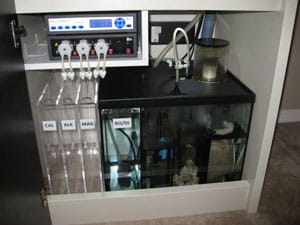
Each of my supplemental fluids sit in 1 gallon jugs. Once I have dosed the gallon jugs of Alkalinity and Calcium I add the Magnesium all in one go.
1 gallon jug = 3,785mls of fluid. Each jug lasts me around 3 months.
I buy my supplements in granular form that make up a gallon of each solution. Each bag for each solution is around $5. Every 3 months it costs me $15.
Supplemental Dosing costs me roughly $0.02 per gallon each month.
(25 Gal Aquarium = $0.02month)
(50 Gal Aquarium = $0.03/month)
(100 Gal Aquarium = $0.05/month)
Light Bulbs
Most aquarists are now using LED technology because of its longevity, controllability, reduced operating temperature, and simple color selection. However, LED’s do not cover the entire coral as well as T5 or Metal Halide and shadowing can occur.
T5 bulbs that are run for 12 hours each day are recommended to be replaced every 9 – 18 months. I replace mine every 12. I offset each bulb so that I don’t change then all at once and shock the coral.
I run 2 ATI Coral+ and 2 ATI Blue+ T5 bulbs to supplement my LED array.
Each ATI bulb costs me approximately $22.00
If you run Metal Halide lights, each bulb will need to be replaced every 12 months with each one costing between $50-$100.
If you run a 4 bulb T5 with 3 bulb Metal Halide Hybrid light fixture you could be looking at a bulb replacement cost of almost $400 each year!
Food
A good variety of food types is essential in any aquarium to help provide nutrition to every organism living in your tank. A selection of food delivery types is also essential to ensure that all your livestock get a chance to eat.
Some fish can be picky, some fish can be timid, some invertebrates are slow-moving and some animals are just pigs. A good selection of stock that can be built up over time is the best way to provide variety to your livestock.
Frozen Cubes/Food
In my opinion, every aquarium needs to be supplied with good quality frozen food at least several times per week. The nutritional benefits from the food are second to none and it makes getting even the pickiest eaters to feed.
Before I made my own I would feed one block to my reef every second evening. The average blister pack would last me 2 months. I would always have several packs on the go of different food types to ensure the diet remained varied.
Most blister packs range from $5-$15 each. I used to always buy one or two when I went to the fish store.
I always defrosted the block and rinsed it before adding it to my aquarium as they can contain a lot of phosphates and nitrates in the fluids before being frozen.
Frozen Blister Packs used to cost me roughly $7 each month.
I would always buy one each time I visited the fish store and had 5-6 different varieties in my freezer at any one time.
DIY Frozen Food
I began to make my own frozen food about 5 years ago and it saves so much more on my frozen food bill! You can make a lot more food and it lasts forever if you vacuum pack the batches.
I buy the following from the grocery store to make my frozen food:
- Peeled Shrimp
- Squid
- Clam Meat
- Mussel Meat
- Scallops
- Seafood Medley
- Nori Sheets to shred
- or any combination of…
I try and buy them fresh then put them in a blender with a small bit of freshly mixed saltwater. It gets blended together then inserted into vacuum bags, vacuumed and frozen into flat sheets.
Each bag is then removed and transferred to a ziplock bag for when its in use. Each night I shave off some of the food into a shot glass containing aquarium water, allowed to defrost then fed to my reef. Everything goes mad!
This blended mix will last me a year of feedings for around $20. The only frozen food I now buy from the fish store is frozen sheets of Mysis Shrimp to add to the frozen blend.
Pellets
Sinking pellet food is a great way to feed every fish and coral too. I have used the New Life Spectrum (NLS) range of pellet foods for years and they are fantastic. A little goes a long way and with a variety of pellet sizes, they have a food size for every mouth.
An $8 tub will last me all year. I feed pellets every morning and may add some to the frozen food shot glass in the evening.
Flakes
I like to break up some flakes into the shot glass a few times per week to help with variety in the diet. I like the Ocean Nutrition Range of flaked food as it doesn’t leave an oil slick on the water surface like some of the cheaper brands can do.
A $5 tub of flaked food will last me a year.
Freeze Dried
I like to add in freeze-dried plankton once or twice a week to the shot glass. This is more to give the coral a different diet to the regular juices and microscopic foods I feed them. A little goes a long way. It usually comes in cubes so I just break up a part of the cube into the shot glass to prevent feeding too much.
A $12 jar of freeze-dried food will last me a year.
Nori/Seaweed
If you have herbivores like Tangs this is an absolute must. If your fish are fat and happy they are less likely to pick at your coral or pester inverts. I will generally add a 4″x8″ strip folded up and clipped to a Nori Clip every 2 days.
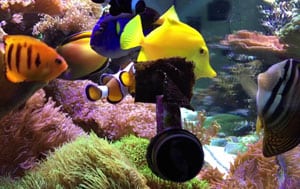
Buying Nori/Seaweed in the local fish store can get expensive, but if you look in the Asian food section of your local grocery store you can find a slab of sheets for a few bucks. Just be sure to get the natural, un-processed sheets.
A grocery store pack of Nori will last me 6 months, whereas an $8 pack from the fish store may only last me a few weeks!
Coral Frenzy
Once the dietary needs of my fish is taken care of its now time to feed the corals. I feed Coral Frenzy about 3 times per week just as I go to bed and the aquarium lights are almost off. Most coral feed at night and by doing it this way the fish are all settled into their sleeping holes and it allows the coral and inverts to feast.
I like to feed the Coral Frenzy Powder as a little goes a very long way and it’s easily captured by the polyps on all my corals.
A tub of Coral Frenzy Powder will last me well over a year for $18.
Reef Chili
The food that started the Aquarium Powerhouse of Bulk Reef Supply! This is by far the best coral food on the market. Designed by Ryan the Co-Founder of Bulk Reef Supply, this food provides everything your corals need to give them rapid growth and beautiful coloration.
Another product that a little goes a very long way. Just Like coral frenzy, I feed this just before lights out and this one tub has lasted me years!
A tub of BRS Reef Chili will last me well over 2 years for $13.
Garlic Extreme
Garlic is proven to boost immune system health in humans and animals alike. I have been feeding Kent Garlic Extreme from day one in my aquarium and I always recommend it to aquarium owners. 2 drops get added to my shot glass every day and allowed to soak into the food before feeding.
Touch wood, I have never had a disease, illness or parasite in my aquarium and I’m sure this is part of the solution.
A bottle of Garlic Extreme will last me a year for $13.
To Finish
Trying to plan and budget for your next or current aquarium is fairly easy once you know what equipment you have, your maintenance schedule, your utility rates and the amount of livestock you have.
I have tried to be as close to costings as I can with this article but it is only to be used as a guide and hopefully, I have shown you how to calculate your own costs without too much effort.
Having a budget can really help to set aside money into your ‘Aquarium Fund’ so that when products like salt come on offer you can buy multiple to help you save even more.
If you are looking for ideas, costs, and equipment to set up an aquarium, please click on any of the pictures below to send you to that aquarium size guide:
Further Reading
To help you further your knowledge on some of the topics in this article you might find the following articles useful:

